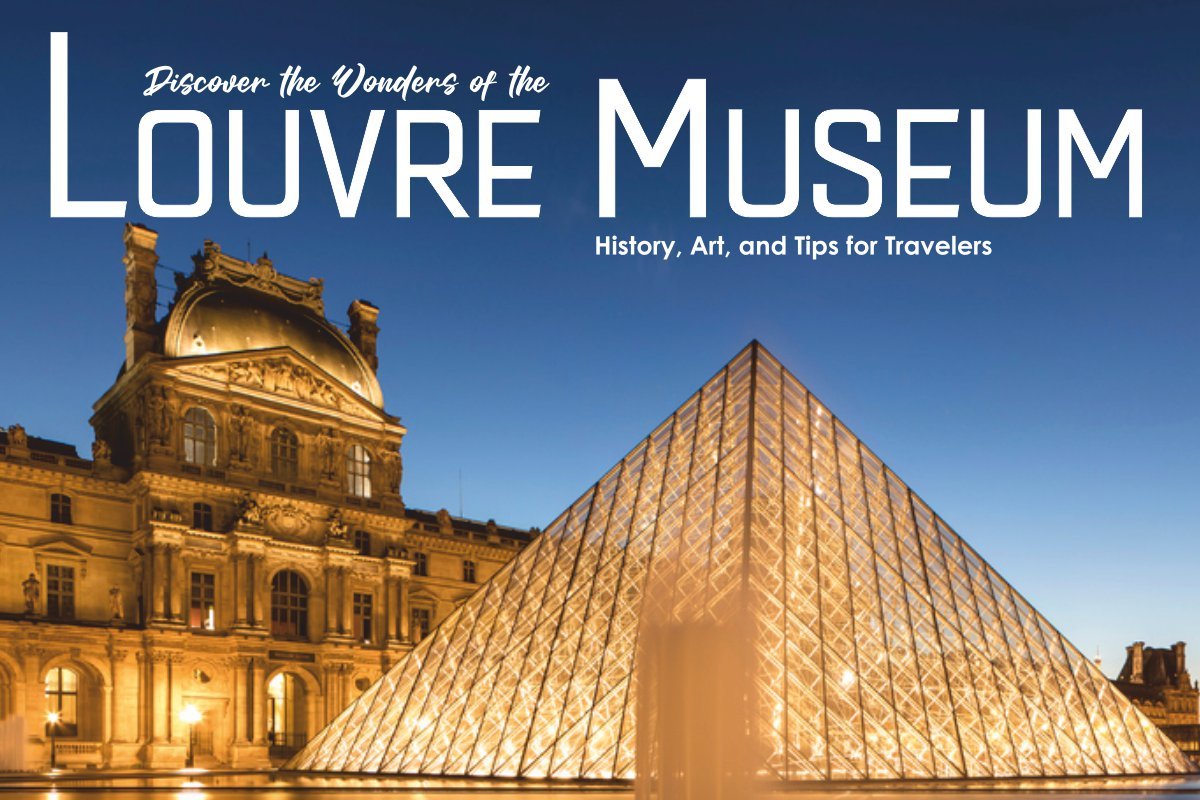Did you know the Louvre Museum is the world’s largest museum, covering over 7,82,000 square feet? You can imagine its vastness: If you spent 30 seconds viewing each part of the museum, it would take you around 200 days to see everything. Home to over 35,000 works of art, including the iconic Mona Lisa and Venus de Milo, the Louvre is not just a museum, it is a journey through centuries of human creativity, history, and culture, all under one remarkable roof.
In this article, you will uncover many secrets of the Louvre, including its rich and fascinating history, architecture, some interesting facts, how it became a tourist attraction, and a brief guide for travelers.
Where Is the Louvre Museum Located?
The Louvre is located in Paris, France, on the right side of the River Seine. It’s in the central part of the city, close to famous places like the Tuileries Gardens. The museum’s main entrance is marked by a large glass pyramid.
Rich and Fascinating History

The Louvre Museum has a rich and fascinating history that dates back to the 12th century. Originally built as a royal palace by King Philip II, it was later transformed into a museum during the French Revolution in 1793. The decision to open it to the public was part of a broader effort to share France’s royal treasures with the people.
Over the years, the Louvre has expanded, with several additions, including the iconic glass pyramid entrance designed by architect I. M. Pei in 1989. It houses more than thousands of art work, spanning thousands of years and cultures, from ancient civilizations to modern times.
The museum features extensive collections of Egyptian, Greek, and Roman antiquities, as well as French and European paintings. The Louvre continues to captivate visitors with its remarkable history and vast array of art, making it one of the most visited museums in the world. It is not just a museum but a symbol of France’s cultural heritage and the world’s artistic achievements.
Tips for a Stress-Free Visit to Louvre Museum
Planning ahead can make your trip to the Louvre more enjoyable and less overwhelming. Here are some tips to help you navigate the museum with ease and make the most of your visit.
1. Plan your visit
Buy your tickets in advance to avoid waiting in the queue at the ticket counter. You can select the date and time to book tickets online. Priority entrance at the Pyramid or through the Carrou du Louvre shopping mall. There is also special entrance available for e-ticket holder -Rue de Rivoli.
2. Get the museum map
Looking at the vastness of the museum it would be better to keep the museum map running in your phone to guide you viewing the special art pieces. You can choose the map in the 13 languages and the information of the maps from the desks under the pyramid or download it from the museum’s website. Maps will help you find the artwork locations and get a 3D guide through the museum. Free audio commentary is also available for a small fee. In case if you forget to download the map free WiFi facility is available in the museum.
3. Avoid the crowds
Most people line up the Pyramid entrance, so try using the Carrousel du Louvre entrance for the quick entrance. The museum is also quieter in the evening and the rooms vibe can be enjoyed peacefully. For the special experience you can visit during late night on the Fridays when the museum stays open until 9:45 p.m.
4. Take advantage of the free services
The Louvre offers free services like wheelchairs, strollers, and baby carriers. You can borrow them easily showing your ID proof at the reception under the pyramid. The museum has 23 information available, making it easier to navigate, and the reception area has been redesigned for better accessibility.
5. Take a Break
It’s near to impossible for anyone to enjoy the 35000 art work pieces in a single visit. You will need to take break and refuel. There are 15 cafes and restaurants inside the Louvre, the Jardin des Tuileries, or the Carrousel du Louvre, offering the dine-in and take-out options. You can relax here and enjoy the tasty dishes.
Foods to Try

When visiting the Louvre Museum, make sure to indulge in some of France’s iconic culinary delights. From flaky pastries to savory tarts, here are five must-try dishes that perfectly capture the essence of French cuisine.
1. Croissant
A classic French pastry made with simple ingredients like flour, butter, sugar, salt, yeast, and milk. Its distinctive flaky texture comes from layers of butter folded into the dough, making it crispy on the outside and soft on the inside.
2. Quiche Lorraine
This savory tart is made with a buttery pastry crust filled with eggs, heavy cream, bacon (or lardons), and Gruyère cheese. Some versions also include onions or herbs for added flavor. It’s a hearty and satisfying dish often enjoyed at lunch.
3. Macarons
These delicate cookies are made from egg whites, powdered sugar, almond flour, and granulated sugar. The filling can vary, but popular flavors include chocolate ganache, raspberry jam, or vanilla buttercream. Their chewy texture and vibrant colors make them a favorite treat.
4. Crêpes
Crêpes are thin pancakes made from a simple batter of flour, eggs, milk, sugar, and butter. They can be filled with a variety of sweet ingredients like Nutella, strawberries, or whipped cream, or savory fillings like ham, cheese, and mushrooms.
5. Tarte Tatin
This upside-down caramelized apple tart is made with a buttery pastry crust, apples (usually a variety like Golden Delicious or Granny Smith), sugar, butter, and a hint of vanilla. The apples are caramelized in butter and sugar before the pastry is added, creating a rich, sweet flavor that contrasts nicely with the tart apples.
5 Interesting Facts About Louvre Museum You Didn’t Know

The Louvre is full of fascinating stories and hidden gems beyond its famous artworks. From its rich history to surprising details about its collections, here are some interesting facts you may not know!
- Before becoming a museum, the Louvre was a royal palace built in the late 12th century by King Philippe Auguste. It wasn’t until the French Revolution that it opened as a museum in 1793.
- The museum’s collection spans more than 9,000 years of history and includes artworks from ancient civilizations to modern pieces, making it one of the most diverse collections in the world.
- Designed by architect I. M. Pei, the glass pyramid entrance was met with strong opposition when it was unveiled in 1989, with many critics arguing it didn’t fit with the classical architecture of the Louvre.
- In 1911, the Mona Lisa was stolen by an Italian handyman, who kept it hidden for two years. The painting was returned to the Louvre in 1913 after being recovered in Italy.
- In 1989, the museum closed part of its facilities for extensive renovations, including the installation of the glass pyramid and reorganization of galleries, reopening with a refreshed look in 1999.
Conclusion
The Louvre Museum is not just a place to see art; it’s a journey through history and culture. With its amazing collection and famous works of art, the museum attracts millions of visitors each year. Whether you’re enjoying the artwork, tasting French food, or learning about its history, a trip to the Louvre is an experience you’ll never forget. Planning ahead will help you make the most of your visit and enjoy everything the museum has to offer.









